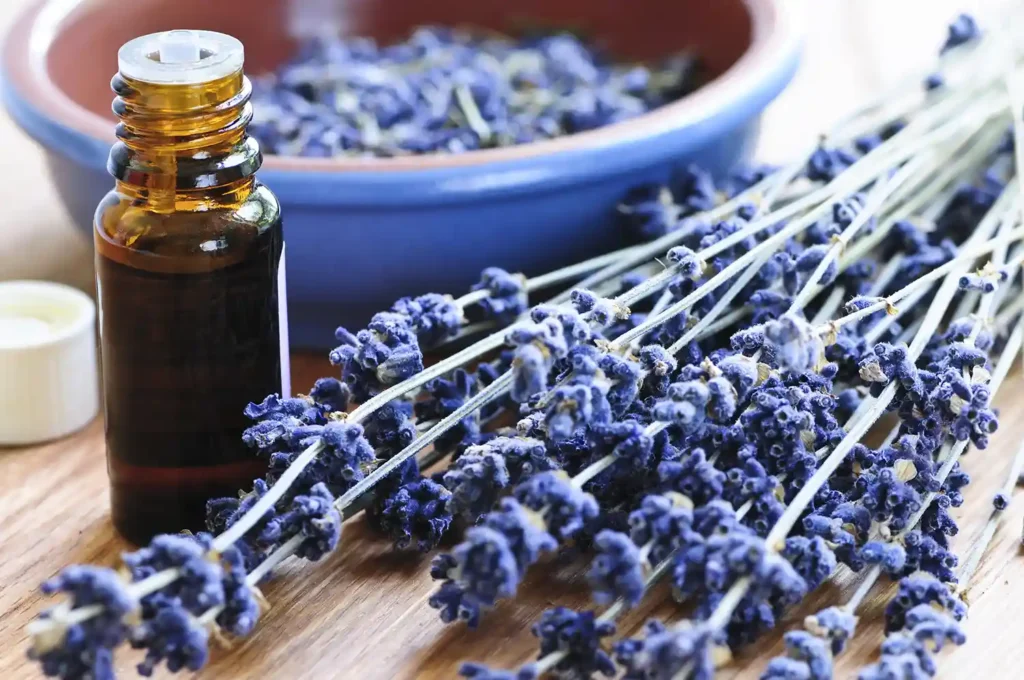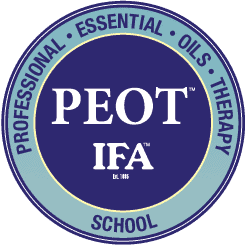Aromatherapy is a holistic healing therapy that uses natural plant extracts, more commonly referred to as essential oils, to promote physical and mental well-being. It has been used in everyday life in different cultures worldwide for centuries. Now, it’s becoming more popular as people look for natural remedies. Using essential oils through aromatherapy can profoundly impact human health and be easily incorporated into our daily lives.
What is Aromatherapy?
Aromatherapy is the practice of using essential oils to improve our mental, emotional and physical health. Essential oils are the plant’s essence and carry plants’ natural fragrance and therapeutic properties. When these aromatic oils are inhaled or applied to the skin, they can directly affect our body and mind.
The molecules in essential oils are small enough to penetrate the skin and enter the bloodstream, where they can interact with the body’s chemistry. When inhaled, the scent molecules travel through the olfactory system and stimulate the limbic system, which is responsible for emotions, memory, and behaviour. This is why certain scents can evoke specific emotions or memories.
The benefits of aromatherapy are vast and varied. Different oils reduce stress and anxiety, improve sleep quality, boost mood and energy levels, relieve pain and inflammation, enhance cognitive function, and support overall immune health. Aromatherapy can be used as a complementary therapy alongside conventional medicine or as a standalone treatment for specific conditions.
Historical Context of Aromatherapy
Ancient Civilisations and Aromatherapy
Aromatherapy has a rich history that dates back thousands of years. The ancient Egyptians used aromatics for religious rituals, beauty treatments, and embalming practices. They understood that these oils had healing properties, and their intention in using them was to connect them to their gods.
In Ancient Greece, Hippocrates, the father of modern medicine, used aromatic plants and oils in his treatments. He understood that the body had an innate ability to heal itself and that aromatherapy could support this natural healing process.
Aromatherapy also has roots in Traditional Chinese Medicine and Ayurveda, the traditional medicine of India. These ancient healing systems recognised plants’ power and ability to restore balance and harmony to the body.
Modern Revival and Popularity
In recent years, there has been a resurgence in the popularity of essential oils and how essential oils work. This is due to the increasing preference for natural botanical extracts and oils over artificial derivatives, which are believed to pose health risks. Consumers becoming more conscious of health issues has increased the demand for organic and natural hygienic products. This has contributed to the growth of the global essential oils market.
The National Cancer Institute published this about using aromatherapy with essential oils in treating people with cancer. It gives much detail about managing allopathic cancer treatments’ side effects. It also includes a brief history of aromatherapy, a review of laboratory studies and clinical trials, and possible adverse effects associated with aromatherapy use.
Essential oils are widely used in the cosmetic industry as a fragrance and active component. Essential oils are significant in cosmetics and cosmeceutical products. They have pleasant aromas and bioactive properties, such as anti-ageing and antimicrobial effects. This is reinforced by recent research into oils, which enables marketing departments to give customers quality assurance for their products.
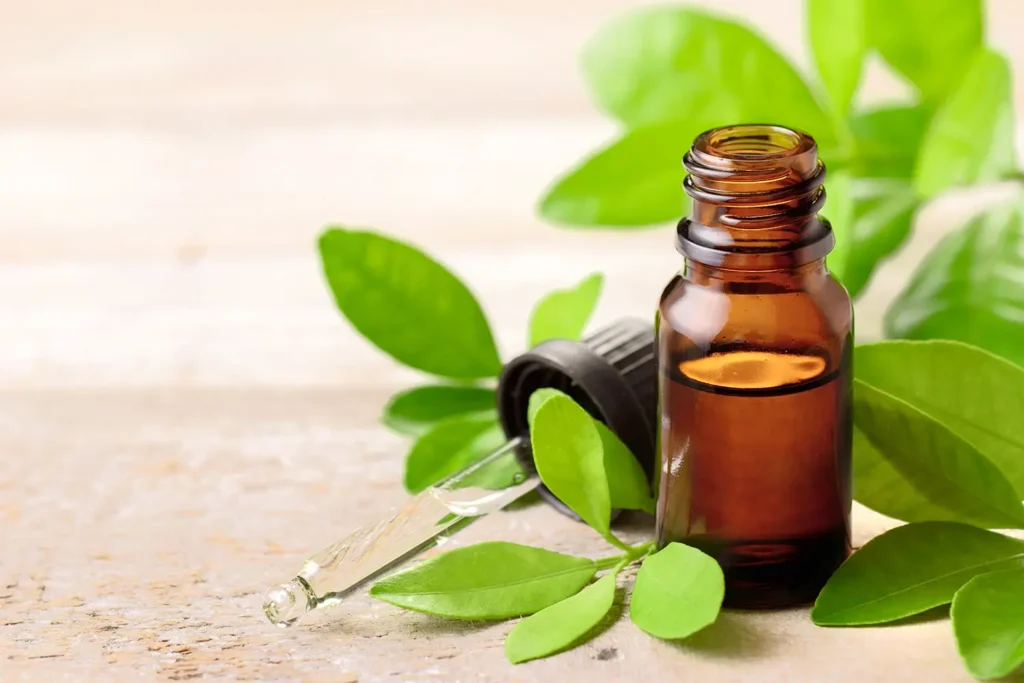
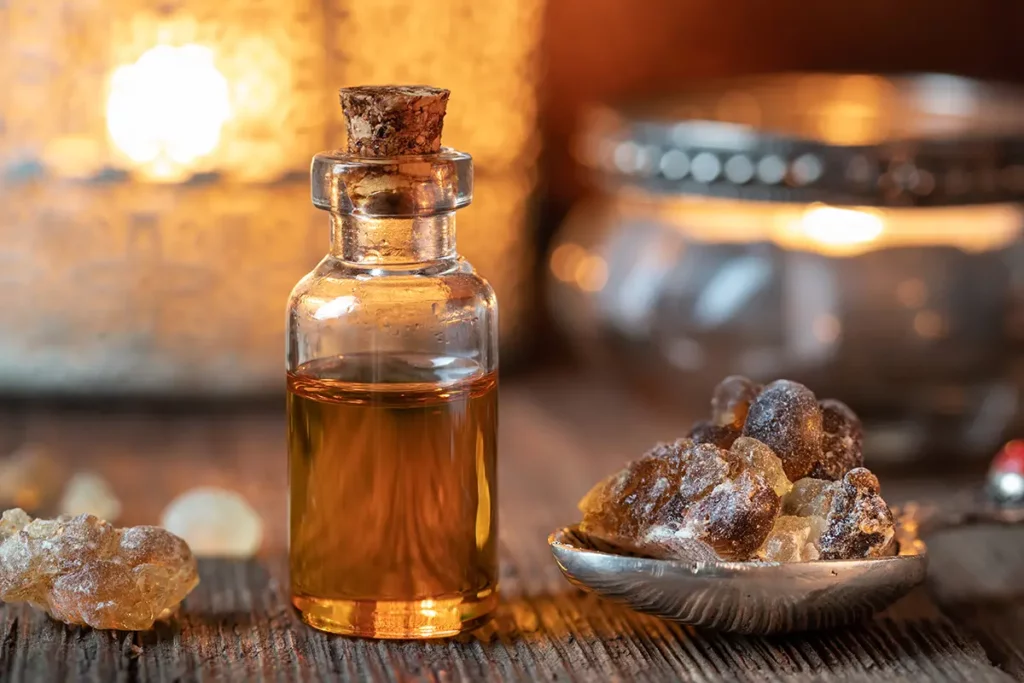
Basic Principles of Aromatherapy
The science behind aromatherapy lies in the chemical composition of essential oils and how they interact with the body. Essential oils comprise various chemical compounds, including terpenes, esters, alcohols, and ketones. Each compound has unique properties and can have different effects on the body.
How Does Aromatherapy Work?
When essential oils are inhaled, the molecules in the essential oils travel through the nose and stimulate the olfactory system. This system is directly connected to the limbic system, which is responsible for emotions, memory, and behaviour. This system then sends signals to other parts of the brain and body, triggering various physiological responses.
When applied topically, essential oils can be absorbed through the skin and enter the bloodstream. From there, they can travel to different organs and tissues, where they can have a direct effect on cellular function. Of course, you must remember to make essential oils safe to use topically by blending them into a carrier oil or an oil blend.
The therapeutic effects of inhalation are felt reasonably quickly, whereas topical application using oils, gels, and creams takes longer to be noticed. However, topical application can benefit a specific target area (such as localised pain relief).
Certain essential oils also have antimicrobial properties that can help combat bacteria and viruses. For example, Tea Tree oil (Melaleuca alternifolia) contains terpinen-4-ol, a compound known for its antifungal effects. When diffused into the air, this oil may eliminate pathogens lurking on surfaces or floating in the atmosphere. When used on your feet in a foot gel, it can eliminate fungal infections such as athlete’s foot.
The Science Behind Aromatherapy
There is ongoing research using essential oils. For example, this study has been assessing the use of essential oils for memory, cognitive performance and improving sleep quality. There is always a gap between testing on animals and actual human trials.
Mind-Body Connection
The mind-body connection is a complex and fascinating concept, and aromatherapy has emerged as a powerful tool for exploring this relationship. Aromatherapy involves the use of essential oils to promote physical and psychological wellness. These aromatic compounds have the potential to influence our emotions and mental state directly through our olfactory system.
When we inhale an essential oil, it triggers specific receptors in our nose that send signals to the brain’s limbic system. This system regulates emotional responses, memory formation, and overall mood. By stimulating this part of the brain, aromatherapy can invoke feelings such as relaxation, calmness, or even revitalisation.
Essential Oils: The Heart of Aromatherapy
Essential oils are the heart and soul of aromatherapy. Many different essential oils are available, each with a unique scent and therapeutic properties. Essential oils are extracted using several methods, including steam distillation, cold pressing, and solvent extraction.
Extracting Essential Oils
There are several methods of extraction, each with its advantages and disadvantages. Most essential oils are mainly produced by steam distillation. This process uses steam to release the oil from the plant material. The vapour then condenses into liquid form. This technique ensures a high-quality product but can be time-consuming and requires specialised equipment. This is typically used for essential oils like Lavender and Tea Tree oils.
Cold pressing is used for citrus fruits and involves mechanically pressing the rinds of the fruit to extract the oil. This gives excellent quality essential oils and utilises waste products from the juicing industry.
Not all essential oils can withstand the process of steam distillation. Typically, they are very delicate flowers like Jasmine. Solvent extraction is a popular choice for these oils, where solvents like ethanol or hexane dissolve the essential oils from plant material. This method produces relatively large quantities of oil but may leave traces of solvents in the final product unless proper purification steps are taken.
The CO2 extraction method is a more recent approach that uses carbon dioxide as a solvent. It requires specific pressure and temperature conditions to produce a pure end product without any leftover chemicals. A high altitude Lavender essential oil is also available as a CO2 extraction, and it is exquisite, being very much in demand by high-end perfumers.
An exciting aspect of extracting essential oils is how different parts of the same plant can produce variations in scent profiles. For example, Lavender oil extracted from the flowers tends to have a sweeter aroma than the oil extracted from the leaves or stems of the plant. When the same plant is grown at a higher altitude, the flowers produce more esters, which gives a more fruity aroma.
Commonly Used Essential Oils and Their Benefits
One commonly used essential oil is Lavender (Lavandula angustifolia). Known as a calming essential oil, Lavender oil can help promote relaxation and reduce stress. Additionally, it has been found to improve sleep quality and alleviate anxiety and depression symptoms.
Another widely utilised essential oil is Peppermint oil (Mentha piperita). The strong and refreshing aroma of Peppermint is not only pleasant but also offers a range of advantages. It has been shown to relieve headaches, soothe muscle aches, and improve digestion. Inhaling Peppermint essential oil can also ease congestion caused by seasonal allergies or colds. When applied in a balm, it can cool hot and inflamed joints.
Eucalyptus essential oil (Eucalyptus globulus) is another popular choice with various beneficial properties. Its potent fragrance makes it an excellent option for promoting mental clarity and focus. Eucalyptus oil helps with respiratory problems like coughs and sinus congestion. You can apply it to your skin or inhale it through steam inhalation.
You will often see essential oils being sold as “therapeutic grade”. No such category exists, and the term is not recognised by any government agency or respected aromatherapy body. The sellers are trying to convince you this oil is worth paying extra for. As no such category exists, there is no legislation for this quality. Of course, you want to avoid buying a fragrance oil for use in aromatherapy.
By checking the INCI and, if they have one, asking for the spec sheet will give you confidence that you are buying a quality product. Training with Purodem is an excellent guide to essential oils, which will ensure you use essential oils safely. You will also learn about all the carrier oils you could want! The professional training modules will ensure you can qualify and become insured in professional essential oil therapy.
Using Aromatherapy Safely
Just because aromatherapy is natural, it does not mean you should be careless when using it. Essential oils are highly concentrated and potent; improper use can cause adverse reactions.
Here are some precautions to take when using essential oils:
Dilute essential oils: Essential oils should always be diluted in a carrier oil before applying them to the skin. This helps to prevent skin irritation and sensitisation. The general rule of thumb is to use a 1% to 2% dilution in one of the common carrier oils like Sweet Almond or Jojoba. The Purodem training modules offer comprehensive coverage of this topic.
Patch test for sensitivity: Before using a new essential oil, it is recommended to perform a patch test to check for any allergic reactions or sensitivities. Apply a small amount of diluted oil to a small skin area and wait 24 hours to see if any redness, itching, or irritation occurs.
Avoid contact with eyes and mucous membranes: Essential oils should never be applied directly to your eyes or mucous membranes. If accidental contact occurs, flush the area with a carrier oil or milk to dilute the oil and see a professional healthcare provider immediately.
Use caution during pregnancy and with children: Some essential oils are unsafe to use during pregnancy or with young children. It is important to talk about things with a qualified aromatherapist or healthcare professional before using essential oils in these situations.
Check for conflict with medications: Check this with your medical provider. For example, if you’re taking medication that depends on your liver function, using an essential oil that promotes liver cleansing could cause issues.
Do’s and Don’ts in Aromatherapy
Do research and educate yourself about essential oils before using them.
Do start with a small amount of essential oil and gradually increase if needed.
Do store essential oils in dark glass bottles away from heat and sunlight.
Do keep essential oils out of reach of children and pets.
Do consult with a qualified aromatherapist or healthcare professional for personalised advice.
Don’t use essential oils undiluted on the skin.
Don’t ingest essential oils unless you have received personalised, expert guidance.
Don’t use essential oils near open flames or heat sources.
Don’t use essential oils on broken or irritated skin.
Don’t rely solely on essential oils for serious health conditions.
Correct Dosages and Application
Be aware that if you are diffusing essential oils in a crowded environment, everybody is experiencing something from that experience. Take careful thought about which oils you are diffusing.
For example, diffusing Orange essential oil will generally be considered safe for most people. However, diffusing Fennel seed can drop blood pressure levels and, therefore, is unsuitable for anyone with low blood pressure. When applying essential oils in a cream, gel or oil, work out the appropriate and safe dosage for that oil.
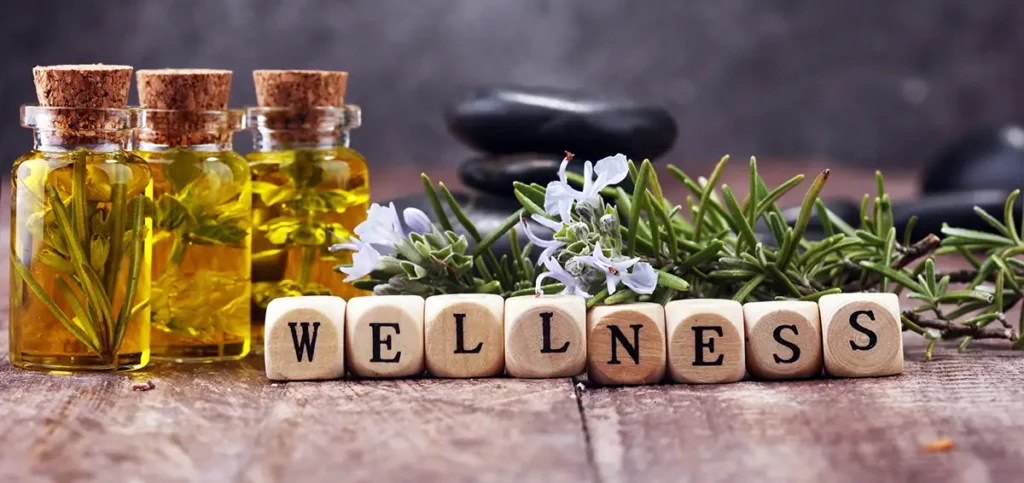
Aromatherapy for Wellbeing
Aromatherapy can have a profound impact on our mental and physical health. Here are some ways in which aromatherapy can improve our health:
Stress and anxiety relief: Certain essential oils, such as Lavender, Roman Chamomile (Anthemis nobilis), and Bergamot oil (Citrus aurantium bergamia), have calming properties that can help reduce stress and anxiety. Inhaling these oils or using them in a diffuser can promote relaxation and a sense of calm.
Sleep support: Essential oils like Lavender, Vetiver oil (Vetiveria zizanoids), and Cedarwood (Juniperus virginiana or Cedrus atlantica)can help promote a restful night’s sleep. These oils can be diffused in the bedroom or applied topically to the wrists or soles of the feet before bedtime.
Mood enhancement: Citrus oils, such as Lemon (Citrus limon), Orange (Citrus aurantium dulcis), and Grapefruit (Citrus paradisi), have uplifting properties that can boost mood and energy levels. Inhaling or using these oils in a diffuser can help improve focus and concentration.
Pain relief: Essential oils like Niaouli (Melaleuca quinquenervia), Eucalyptus, and Fragonia™ (Agonis fragrans) have analgesic and anti-inflammatory properties that can help relieve pain and inflammation. These oils can be diluted in carrier oil and massaged onto the affected area.
Immune support: Essential oils like Tea Tree, Eucalyptus, and Oregano (Origanum vulgare) have antimicrobial properties that can help support the immune system. These oils can be diffused in the air or used in cleaning products to help kill germs and prevent illness.
Emotional and Psychological Benefits
Managing Stress and Anxiety
Lavender is one of the most popular essential oils for relaxation. It has a calming scent that can help to reduce anxiety and promote sleep. You can diffuse Lavender oil in your home or office or apply it to a handkerchief to inhale throughout the day.
Bergamot is a citrus oil that has a bright and uplifting scent. It can help to reduce feelings of stress and anxiety, as well as improve mood. You can diffuse bergamot oil using a USB diffuser that plugs into your laptop or as a diluted rollerball on your wrists.
Chamomile is known for its calming properties and is often used to promote relaxation and sleep. You can diffuse chamomile oil or apply it in a diluted roller ball topically to your temples or the back of your neck.
Ylang Ylang (Cananga odorata) has a sweet floral scent that can help to reduce stress and promote relaxation. It is often used in aromatherapy to balance emotions and uplift mood. Be sure to start with just one drop; it is very intense, and too much can make you feel nauseous. Therefore, it is best to add a drop to a tissue to wear or have it near you.
Frankincense (Boswellia carterii) has a woody and earthy scent that can help to reduce stress and anxiety. It is often used in meditation practices to promote relaxation and focus. You can diffuse Frankincense oil or add a couple of drops to a tissue and tuck it behind a radiator for a gentle effect.
Learn more about using Aromatherapy Oils To Help Ease Stress and Anxiety.
Boosting Mood and Emotional Balance
Lavender essential oil is known for its calming and soothing properties. It can help reduce stress and anxiety, promote relaxation, and improve sleep quality.
Bergamot oil has a citrusy scent that is uplifting and refreshing. It can help relieve stress, anxiety, and depression and promote a positive mood.
Ylang Ylang oil has a sweet floral scent known for its calming and uplifting properties. It can help reduce stress, anxiety, and depression and promote relaxation.
Chamomile oil has a calming and soothing scent that can help reduce stress, anxiety, and insomnia. It can also help promote relaxation and improve sleep quality.
Frankincense oil has a woody and earthy scent known for its grounding and calming properties. It can help reduce stress, anxiety, and depression and promote emotional balance.
Clary sage essential oil (Salvia sclarea) oil has a sweet and herbaceous scent known for its mood-boosting properties. It can help reduce stress, anxiety, and depression and promote relaxation.
Lemon oil has a fresh, citrusy scent that is uplifting and energising. It can help improve mood, reduce stress, and increase focus and concentration.
Peppermint oil has a refreshing minty scent that can help boost energy levels and improve focus and concentration. It can also help relieve stress and tension headaches.
Physical Health Benefits
Improved respiratory health: Eucalyptus, Peppermint, and Tea Tree oil have antimicrobial properties that can combat respiratory infections and enhance breathing.
Reduced inflammation: Several essential oils, including Lavender, Chamomile, and Frankincense, have anti-inflammatory properties that can help reduce inflammation and relieve pain.
Enhanced immune function: Certain essential oils, like Lemon, Oregano, and Thyme, can strengthen the immune system and guard against illness due to their antimicrobial properties.
Improved digestion: Ginger, Peppermint, and Fennel can help improve digestion by reducing bloating, gas, and indigestion.
Pain relief: Fragonia™, Plai, Lavender, Peppermint, and Rosemary oil have analgesic properties that can help relieve pain from headaches, muscle aches, and joint pain.
Reduced stress and anxiety: Essential oils such as Bergamot, Chamomile, and Lavender have calming properties to help reduce stress and anxiety.
Improved sleep quality: Lavender and Chamomile can promote relaxation and enhance sleep quality before bedtime.
Skin health benefits: Lavender, Tea Tree oil, and Frankincense oils have antibacterial properties that can help treat acne, reduce inflammation, and promote healthy skin.
Headache relief: Peppermint can relieve tension headaches when applied topically or inhaled.
Increased energy levels: Citrus essential oils like Lemon or Orange can provide a natural energy boost when diffused or applied topically.
Easing Pain and Inflammation
Fragonia™ oil and Plai oil both have anti-inflammatory properties and can help reduce pain and swelling.
Ginger oil (Zingiber officinalke) has analgesic and anti-inflammatory properties that can help relieve pain and reduce inflammation. It is commonly used for arthritis, muscle aches, and digestive issues. Note that as a warming oil, it is best used on conditions with a cold discomfort or pain.
Frankincense oil has anti-inflammatory properties that can help reduce pain and swelling. It is often used for arthritis, muscle aches, and respiratory conditions.
Peppermint contains menthol, which has a cooling effect on the skin and can help relieve pain and inflammation. It is commonly used for headaches, muscle aches, and joint pain that feel hot.
Eucalyptus oil has anti-inflammatory and analgesic properties, which make it effective in relieving pain and reducing inflammation. It is often used for arthritis, muscle strains, and respiratory conditions.
Rosemary oil (Rosmarinus officinalis) has analgesic properties that can help relieve pain and reduce inflammation. It is commonly used for headaches, muscle aches, and joint pain.
Chamomile oil has anti-inflammatory properties that can help reduce pain and swelling. It is often used for arthritis, muscle aches, and menstrual cramps. The chemical properties of this oil are also effective at reducing the inflammation of insect bites.
Be sure to check any of the oils you want to use for contraindications that may not be suitable for you.
Promoting Sleep and Relaxation
Roman Chamomile is an excellent essential oil known for its calming properties on the central nervous system. It can help reduce stress and promote relaxation, making it a perfect choice for bedtime.
Lavender is one of the most popular essential oils for promoting sleep and relaxation. It has a calming scent that can help reduce anxiety and improve sleep quality.
Bergamot is a citrusy essential oil that has a calming effect on the mind and body. It can help reduce anxiety and promote a sense of calm, making it a great oil to use at children’s bedtime.
Ylang Ylang is a floral essential oil that has a sedative effect on the body. It can help reduce stress and anxiety, but ensure you use it slightly and more than a drop can make some people feel nauseous.
Vetiver is an earthy essential oil that has a grounding effect on the mind and body. It can help promote relaxation and improve sleep quality. Tip… If you like the aroma, add a couple of drops to the final rinse compartment of your washing machine when you launder your bedding.
Frankincense is a woody essential oil used for centuries to promote relaxation and improve sleep quality. It can help reduce stress and anxiety; just a drop under your pillow is enough to slow your breathing and let you drift off to sleep.
Read more about The Power of Aromatherapy for Restful Sleep
Integrating Aromatherapy Into Daily Life
Incorporating aromatherapy into your daily routine is easy and can significantly impact your well-being. Here are some ideas for using essential oils at home:
Diffuse essential oils: An essential oil diffuser fills your home with the scent of your favourite essential oils. This can help create a calming or uplifting atmosphere, depending on the ones you choose.
Make a massage oil: You can make a personalised massage blend with just a few essential oils and a vegetable oil like Coconut oil. You don’t have to be a masseur to enjoy the benefits of massage therapy. Apply a teaspoon of this massage oil blend to your arms and legs and gently rub with long strokes. This will sink in quickly if you have just had a shower or bath, and daily self-caring actions like this are a great way to promote health.
Create a relaxing bath: Add a drop or two of Lavender or Chamomile essential oil to a small amount of carrier oil like Sweet Almond oil. Blend this with the same amount of bubble bath and add to your bathwater for a soothing and relaxing experience. The warm water will help to release the aroma molecules, promoting relaxation and stress relief. Remember to rinse the bath afterwards to ensure there is no slippery oil left.no slippery oil is
Make your own cleaning products: Enhance the antimicrobial power of your homemade cleaning products by adding a couple of drops of essential oil such as Tea Tree or Lemon essential oil. These oils can help kill germs and leave your home smelling fresh and clean.
Create a personal fragrance: Mix a few drops of your favourite essential oils with a carrier oil, such as Jojoba or Sweet Almond oil, to create your signature scent. Apply it to your pulse points for a natural and personalised fragrance.
Aromatherapy On-the-Go
Aromatherapy doesn’t have to be limited to your home. Potable aromatherapy products allow you to enjoy the benefits of essential oils wherever you go. Here are some ways to use them while travelling:
Inhalers: An aroma stick is a small, portable cylinder with a wick inside. Add a few drops of essential oil to the wick and inhale at the top of the cylinder. An aroma stick is discreet and easy to use, making it perfect for travel. They are best used with respiratory oils (see above) and are excellent when the air in an aeroplane gets muggy. They are protective, too!
Roll-on bottles: Transfer your favourite essential oils to roll-on bottles for easy and mess-free application. These bottles can be carried in your purse or pocket and applied whenever you need a boost of energy or relaxation. Do remember to dilute them with a carrier oil first, though.
Travel diffusers: Travel-sized diffusers can be used in your car, hotel room, or office. These diffusers are compact and easy to use, allowing you to enjoy the benefits wherever you are.
Aromatherapy jewellery & wearables: Wear aromatherapy jewellery, such as diffuser necklaces or bracelets, to carry the scent throughout the day. These jewellery pieces have a small compartment to add a few drops of your favourite oil.
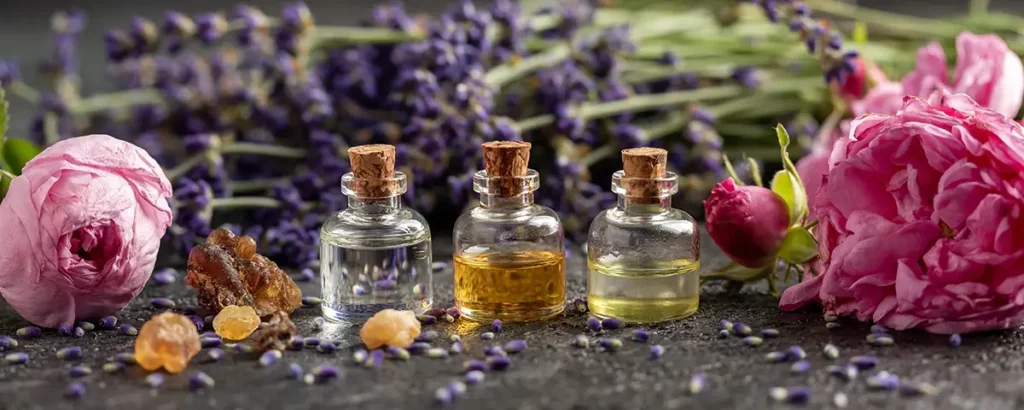
Advanced Aromatherapy Tips
Once you become familiar with the basics of aromatherapy, you can start experimenting with blending many essential oils to create your unique scents. Here are some advanced tips for blending:
Blending Essential Oils
When choosing essential oils, note the ones you want to use and do background research to learn more about them. You will surely find other essential oils you may have yet to think of while you do this.
Top, Middle, and Base Notes Explained
Start with a base note: Base notes are the foundation of a blend and have a grounding and calming effect. Some examples of base notes include Cedarwood, Patchouli, and Vetiver. These are generally strong-smelling, so go easy with the amount you use. You can always add more later but can’t reduce them afterwards.
Add middle notes: Middle notes provide balance and harmony to a blend. They have a balancing effect on the emotions and can help to uplift or calm the mind. Some examples of middle notes include Lavender, Geranium (Pelargonium graveolens), and Ylang Ylang. They act as a link between the base notes and the top notes.
Finish with top notes: Aromatherapy oils evaporate at different rates, and top notes are the first scents that you smell in a blend. They can often have a refreshing and invigorating effect. They are often citrus or herbal oils that provide a burst of energy. Some examples of top notes include Lemon, Peppermint, and Bergamot
Take citric oils as an example. Grapefruit has a short shelf life of about six months and does not project well in a blend. If you want to use Lemon, add essential oils like May Chang as an alternative. It has an intense lemony aroma with a slight sherbet-like fizz to it. This pairs very nicely with Green Mandarin oil, and the green note really pulls things together. The slightest touch of Vetiver will add an earthy note that grounds the citrus ones together. A high altitude Lavender will have more of a fruity note than your normal Lavender, which ties in very well with the top and base notes.
Aromatherapy is a personal practice, and what works for one person may not work for another. Trust your intuition and experiment with different ones to find the blends that resonate with you. Always make notes of the amounts that you have used. That way, you can avoid making a mistake again, but more importantly, replicate the masterpiece you have just created!
The Art of Creating Synergistic Blends
Synergy blends in aromatherapy are carefully thought-out combinations of essential oils designed to optimise the overall effects of oil blends.
When combined, the term “synergy” means that the chemicals in each oil can enhance each other’s effects and create a stronger therapeutic benefit than if used separately.
An example of this might be a blend for pain management. Imagine you are making a blend for someone who has suffered a contact injury while playing sports. They are sore and ache all over. A warm bath with diluted essential oils will feel cleansing and comforting and ease some of the aches and pains by increasing the blood flow to the areas.
If that blend included Plai, that is an excellent oil for physical pain relief. It also smells quite medicinal, and that can feel appropriate. Combine that with Fragonia™ oil, which also has pain-relieving qualities. It also helps with emotional pain, which will significantly benefit in this example. Some Roman Chamomile will ensure a good night’s sleep, and the magic of Fragonia™ will work wonders in the dream state.
Storing and Caring for Your Oils
To ensure the longevity and potency of your essential oils, it is important to store and care for them properly. Here are some best practices for storing them:
- Use dark glass bottles: Essential oils should be stored in dark glass bottles to protect them from light and heat. Amber or cobalt blue bottles are ideal for this purpose.
- Keep oils away from heat and sunlight: Exposure to heat and sunlight can cause essential oils to degrade and lose their potency. Store them in a cool, dark place, away from direct sunlight and heat sources.
- Keep lids tightly closed: Essential oils are volatile substances that can evaporate if not correctly sealed. Always close the lids tightly after each use to prevent evaporation.
- Label your bottles: It is important to label your essential oil bottles with the name of the oil and the date of purchase. This will help you track how long you have had the oil and when to replace it.
To extend your essential oils’ shelf life, handling them with care is important. Here are some tips for caring for your oils:
- Avoid contamination: Essential oils are highly concentrated and can be contaminated if they come into contact with water, dirt, or other substances. Make sure always to use clean droppers or pipettes when handling them. When you take the top off to smell the bottle, ensure the right top goes back onto the bottle. I remember a very expensive Rose oil ruined when someone put a Peppermint oil top on the Rose oil bottle…!
- Avoid using plastic containers: Essential oils can dissolve certain types of plastic, so it is best to avoid storing them in plastic containers. Stick to glass or stainless steel containers for storing and mixing your blends. Make sure to use plastic bottles made of HDPE or PET plastics when you combine essential oils with products like gels, creams, or lotions you have formulated. These plastics have been tested and proven safe and stable for cosmetic products.
- Use carrier oils for dilution: When diluting essential oils for topical use, always use vegetable oil, such as Jojoba, Sweet Almond, or Coconut oil. This helps to prevent skin irritation and sensitisation.
- Keep out of reach of children and pets: Essential oils are potent substances that should be kept out of reach. Accidental ingestion or contact with them can be harmful.
- Allergic reactions: These are not common but are always possible with very sensitive skin. If this applies to you, apply a patch test with individual oils first and wait 24 hours to see if you are OK. During pregnancy, hormonal changes in your body can cause oils you used to tolerate to become problematic. If this happens to you, discontinue use immediately, and if you have safety concerns, speak to your Doctor.
Shelf Life and Preservation
Check the BBE or Use By date on the oil when you get it. You don’t want to accept a short shelf life of only a few months.
Avoiding Contamination and Deterioration
Ensure you replace the right caps on the right bottles and keep them safe in a dark space, as described above.
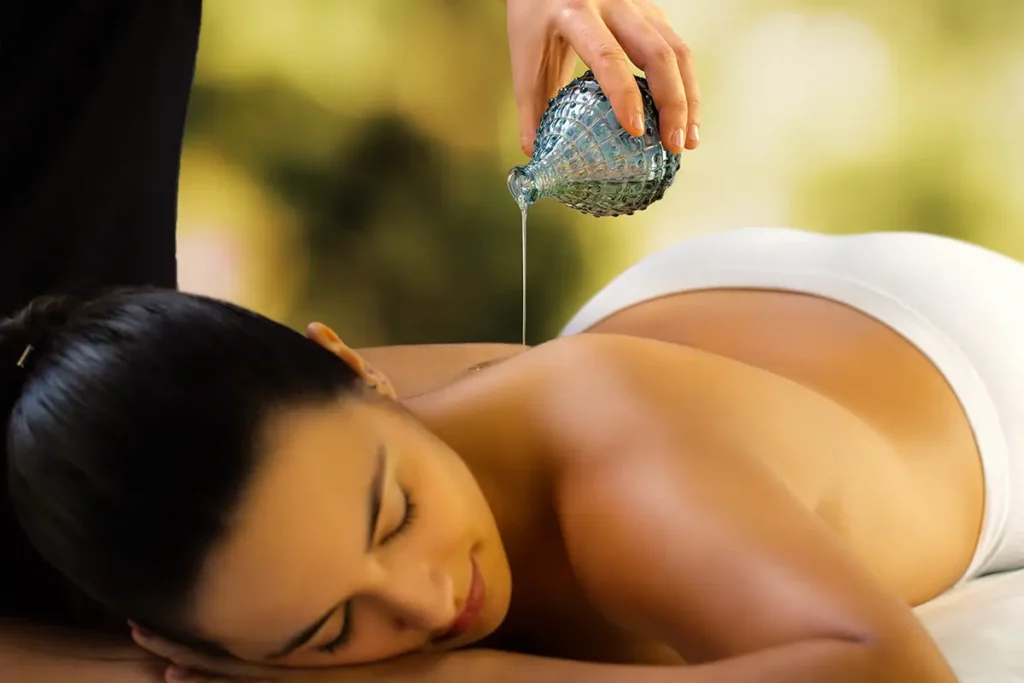
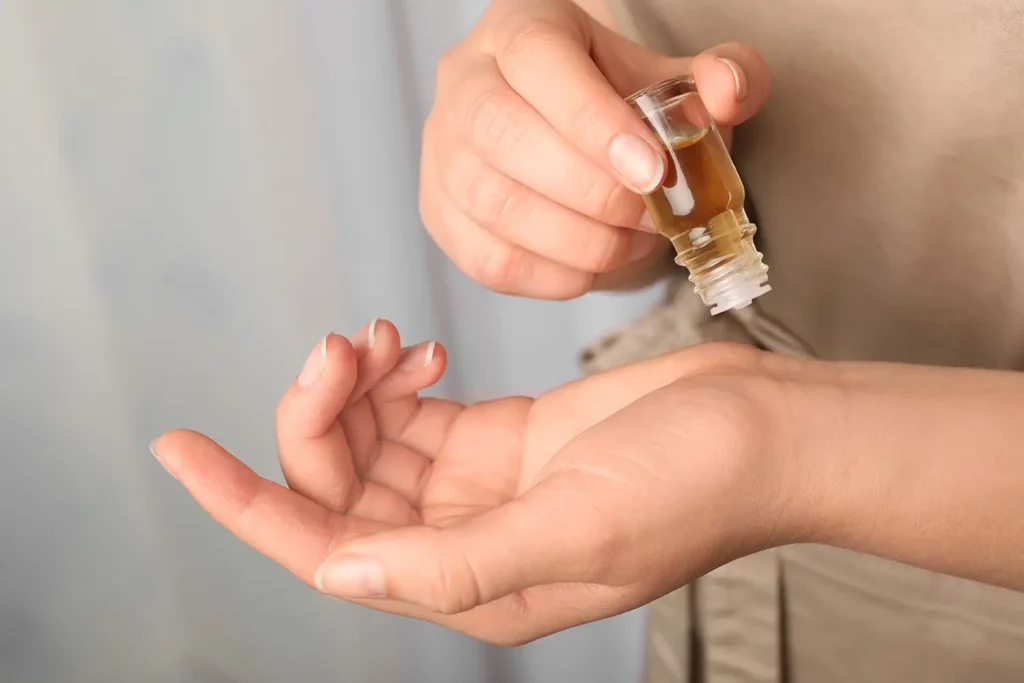
Conclusion: The Endless Possibilities of Aromatherapy
Aromatherapy is a versatile and powerful practice that can profoundly impact our physical and mental health. By harnessing the natural healing abilities of essential oils, we can support our body’s natural healing processes and promote overall health and vitality. Often referred to as alternative medicine, we prefer to call it complementary medicine as it is more accurate with integrative health.
Aromatherapy offers many benefits, like reducing stress and anxiety, improving sleep quality, boosting mood and energy levels, relieving pain and inflammation, and enjoying amazing fragrances. Try it, and you won’t regret it!
Additional Resources
Books and Publications on Aromatherapy
- The Complete Book of Essential Oils & Aromatherapy by Valerie Ann Worwood. It’s been published for many years and is a treasure trove of good information.
- The Fragrant Mind by Valerie Ann Worwood – An excellent book looking at the psychological and emotional aspects of aromatherapy.
- Essential Oil Safety: A Guide for Health Care Professionals by Robert Tisserand and Rodney Young.
- The Encyclopedia Of Essential Oils by Julia Lawless. Again, another classic on aromatherapy.
- The Complete Guide to Aromatherapy by Salvatore Battaglia – a well-respected Australian aromatherapist.
- The Science of Advanced Aromatherapy by Kurt Schaubelt. This is quite advanced, so save it for later in your studies.


